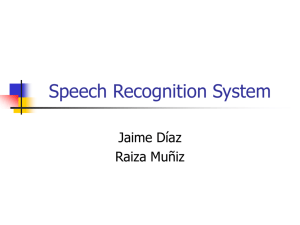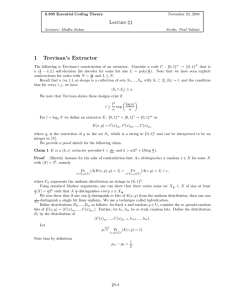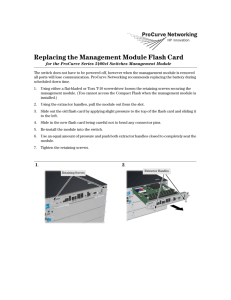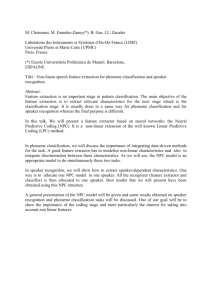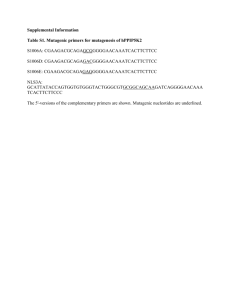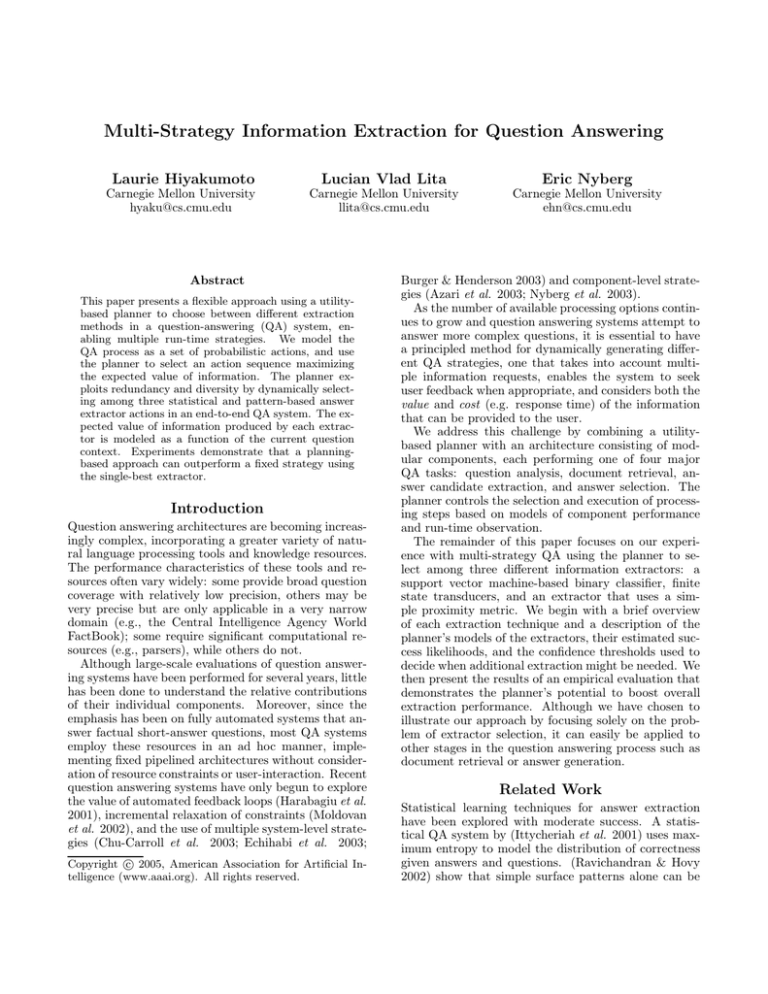
Multi-Strategy Information Extraction for Question Answering
Laurie Hiyakumoto
Lucian Vlad Lita
Eric Nyberg
Carnegie Mellon University
hyaku@cs.cmu.edu
Carnegie Mellon University
llita@cs.cmu.edu
Carnegie Mellon University
ehn@cs.cmu.edu
Abstract
This paper presents a flexible approach using a utilitybased planner to choose between different extraction
methods in a question-answering (QA) system, enabling multiple run-time strategies. We model the
QA process as a set of probabilistic actions, and use
the planner to select an action sequence maximizing
the expected value of information. The planner exploits redundancy and diversity by dynamically selecting among three statistical and pattern-based answer
extractor actions in an end-to-end QA system. The expected value of information produced by each extractor is modeled as a function of the current question
context. Experiments demonstrate that a planningbased approach can outperform a fixed strategy using
the single-best extractor.
Introduction
Question answering architectures are becoming increasingly complex, incorporating a greater variety of natural language processing tools and knowledge resources.
The performance characteristics of these tools and resources often vary widely: some provide broad question
coverage with relatively low precision, others may be
very precise but are only applicable in a very narrow
domain (e.g., the Central Intelligence Agency World
FactBook); some require significant computational resources (e.g., parsers), while others do not.
Although large-scale evaluations of question answering systems have been performed for several years, little
has been done to understand the relative contributions
of their individual components. Moreover, since the
emphasis has been on fully automated systems that answer factual short-answer questions, most QA systems
employ these resources in an ad hoc manner, implementing fixed pipelined architectures without consideration of resource constraints or user-interaction. Recent
question answering systems have only begun to explore
the value of automated feedback loops (Harabagiu et al.
2001), incremental relaxation of constraints (Moldovan
et al. 2002), and the use of multiple system-level strategies (Chu-Carroll et al. 2003; Echihabi et al. 2003;
c 2005, American Association for Artificial InCopyright telligence (www.aaai.org). All rights reserved.
Burger & Henderson 2003) and component-level strategies (Azari et al. 2003; Nyberg et al. 2003).
As the number of available processing options continues to grow and question answering systems attempt to
answer more complex questions, it is essential to have
a principled method for dynamically generating different QA strategies, one that takes into account multiple information requests, enables the system to seek
user feedback when appropriate, and considers both the
value and cost (e.g. response time) of the information
that can be provided to the user.
We address this challenge by combining a utilitybased planner with an architecture consisting of modular components, each performing one of four major
QA tasks: question analysis, document retrieval, answer candidate extraction, and answer selection. The
planner controls the selection and execution of processing steps based on models of component performance
and run-time observation.
The remainder of this paper focuses on our experience with multi-strategy QA using the planner to select among three different information extractors: a
support vector machine-based binary classifier, finite
state transducers, and an extractor that uses a simple proximity metric. We begin with a brief overview
of each extraction technique and a description of the
planner’s models of the extractors, their estimated success likelihoods, and the confidence thresholds used to
decide when additional extraction might be needed. We
then present the results of an empirical evaluation that
demonstrates the planner’s potential to boost overall
extraction performance. Although we have chosen to
illustrate our approach by focusing solely on the problem of extractor selection, it can easily be applied to
other stages in the question answering process such as
document retrieval or answer generation.
Related Work
Statistical learning techniques for answer extraction
have been explored with moderate success. A statistical QA system by (Ittycheriah et al. 2001) uses maximum entropy to model the distribution of correctness
given answers and questions. (Ravichandran & Hovy
2002) show that simple surface patterns alone can be
used to answer some classes of questions. (Echihabi
& Marcu 2003) argue for a noisy-channel approach to
answer extraction that, although statistical in nature,
accommodates the use of knowledge resources. In the
same spirit, (Lita & Carbonell 2004) propose a fully statistical, instance-based approach to question answering
that is easy to train and requires less human effort.
Multi-strategy approaches to QA have also emerged
in recent years. (Chu-Carroll et al. 2003) combine
two end-to-end QA systems, a knowledge-based system
and a statistical system, sharing intermediate results
at the analysis, retrieval, and generation stages in the
process. The MITRE Corporation (Burger & Henderson 2003) has also performed system-level experiments
in which the output of QA systems participating at
TREC2002 were combined using distance-based metrics and n-grams of words and characters. Although
no combination they tested was better than the topperforming system, their results still suggest that combining the outputs of several systems can be effective,
given more training data and better features.
Multi-strategy approaches at the component-level
have been introduced via feedback loops and threshold
settings at intermediate points in the pipeline, enabling
them to repeat stages of the QA process. (Harabagiu
et al. 2001) made use of predefined thresholds to determine when query reformulation and additional retrieval
are necessary. In more recent work, LCC (Moldovan
et al. 2002) has developed a system that attempts to
prove a question logically follows from an answer, using a reasoning mechanism based on axioms extracted
from WordNet glosses. When the proof fails, the system
incrementally relaxes conditions that prevent the completion of the proof. AskMSR-DT (Azari et al. 2003), a
web-based QA system, explores the use of decision trees
to provide answer quality predictions for dynamic generation of query rewriting strategies. Their approach
is similar to the one described here, using the quality
predictions as a heuristic to select a rewrite ordering
and threshold on the number of rewrites to provide.
Approach
Our work has been conducted within the JAVELIN
open-domain QA system, an architecture designed
specifically to support research in multi-strategy question answering (Nyberg et al. 2003). The JAVELIN
system consists of modular components, each performing one of four major QA processing stages distinguished by the system: question analysis, document
retrieval, answer candidate extraction, and selection of
a final answer. A centralized planner module, supplied
with a model of the question answering task and performance estimates for individual components, controls
the overall selection and execution of processing steps.
It communicates with the rest of the system via an execution manager, which decouples the planner’s representation of the information state from the specific input and output formats used by the QA components. A
question
QA process
model
answer
Planner
info. state, action
revised info. state
Execution Manager
...
Modular QA Components
Question analysis, retrieval, extraction, answer selection
Figure 1: A high-level architectural view: The planner controls information flow among modules, selects
among answering strategies, and enables user feedback
depending on the relative utility and the cost of information. The execution manager is an implementation
layer aware of QA module-specific interfaces.
conceptual view of the system’s architecture is depicted
in Figure 1.
While any successful strategy will contain at least one
pass through each of the four major processing stages,
the modular planner-driven architecture also enables
dynamic generation of strategies that invoke multiple
modules within each stage, backtrack to previous stages
if the actual outcomes fail to meet original projections,
and can be tailored to the run-time features and resource constraints of the current question.
We describe our application of this approach to the
problem of determining how to select among three information extractors. As such, the descriptions of the
components in the following subsections are limited to
the implementation of the extraction and planning components. Interested readers are referred to (Nyberg et
al. 2003) for a description of the other modules comprising the JAVELIN system.
Answer Extraction Strategies
The role of the JAVELIN answer extraction components is to identify answer candidates within documents, based on the characteristics of the current question. The input to each extraction module is a linguistic analysis of the question and a small set of potentially relevant documents. The linguistic analysis includes syntactic processing, an expected answer type
(the semantic category of the answer, e.g., location,
date, person) and a question type (a relationship between the question terms and answer, e.g., author-of,
capital-of). The output of each extractor consists of
precise answer candidates in the form of short passages
(e.g., dictionary definitions) or phrases (e.g., proper
names), each with an associated confidence score and a
3-sentence contextual passage centered around the can-
Extraction Using a Proximity Metric Our first
answer extraction method selects candidates using a
non-linear weighted proximity metric. Named entities
(Bikel, Schwartz, & Weischedel 1999) matching the expected answer type (e.g., location, person) are identified and assigned scores based on their proximity to
question terms and term expansions (conjugations, synonyms, etc). Terms found across sentence boundaries
are assigned lower weights when computing the overall
answer confidence.
SVM-Based Extraction Our second strategy views
answer extraction as a classification problem (Figure
2), and employs a binary classifier to classify candidate
answers as either correct or incorrect. Our extractor
is based on a support vector machine (SVM), trained
on a set of features generated from passages containing
correct answers and passages lacking correct answers.
The assumption is that given enough positive and negative training examples, the classifier can generalize and
subsequently be used to classify new candidate answers
accurately. Its output includes a score representing its
confidence in the correctness of a candidate answer.
Question & Candidate
Passage
didate. Many other QA systems blur the concepts of
answer type and question type, merging them into a
common ontology. However, we have found it useful
to maintain the distinction, both for planning purposes
and as features for the statistical extractors. When sufficient training data is available, we have also used them
to develop type-specific extractor models.
Our development of multiple extractors is based on
the premise that no single extraction method is likely
to emerge as the best solution for all questions. We believe that optimal performance across different question
and answer types requires a diverse set of extraction
strategies, ranging from simple proximity measures, to
statistical methods trained to discriminate correct answers from incorrect ones, to methods based on deeper
linguistic and semantic processing. Thus far, three extractors have been implemented using proximity and
statistical methods. Questions expressed in relatively
simple syntax such as “What is the capital of Kenya?”
and of a very common question type (e.g., capital-of)
can frequently be answered using contextual patterns,
WordNet (Miller 1995) structure, gazetteers, dictionaries, encyclopedias, and simple methods such as finite
state transducers. However, these approaches often fail
to reliably answer questions with a more complex structure and a less common question category (e.g., “Which
mountain range in North America stretches from Maine
to Georgia?”). Instead, statistical methods based on a
large number of simple features shared across question
types are likely to produce better answers. Moreover,
there are questions that are ambiguous or difficult to
parse (e.g., “Where is it planned to berth the merchant
ship, Lane Victory, which Merchant Marine veterans
are converting into a floating museum?”). For such
questions, basic term-based proximity methods are a
reasonable backoff strategy.
{Question & Answer}
{Passage+}, {Passage-}
Correct
(Confidence)
Train
Test
Feature Extractor
+
-
Correctness Classifier
Incorrect
(Confidence)
Figure 2: Binary classification approach - A classifier is
trained on a set of questions with passages that contain
the answer (Passage+), as well as passages that don’t
contain the answer (Passage-). The classifier evaluates
answer candidate correctness and assigns them confidence scores.
The feature set used by the SVM extractor includes
surface form features such as n-grams and paraphrases,
passage statistics such as sentence length, the percentage of keywords present in the passage, and metrics
expressing the average distance between the candidate
answer and the expanded question terms. In addition
to a linear distance metric, the SVM uses exponential
and quadratic distance metrics since experiments have
shown that different answer types and different contexts
require different distance functions.
FST-Based Extraction Our final strategy is based
on finite state transducers (FSTs), a technique that has
been successfully applied to other established information extraction tasks (Hobbs et al. 1993). Our FSTbased answer extractor covers only the most frequent
question types, and is appropriate for question types
where most answers can be extracted using a handful
of simple, learnable patterns.
Given a document containing named entities matching the expected answer type, the finite state transducer method estimates the likelihood that each named
entity is actually an answer. A large number of question type-specific FSTs employing simple surface form
patterns, capitalization, sentence and entity boundary
flags, and WordNet features (e.g., overlap with synonyms and hypernyms) were generated from training
data and then filtered for optimal performance on a
validation set. Multiple transducers may match the
same answer candidate, each generating an answer confidence. These confidence scores represent the transducer precision over the training data: the number of
times an FST matches correct answers relative to the
overall number of matches. Figure 3 shows how the
FST strategy operates for a simple question type.
Planning
The role of the planner is to find and execute a sequence of actions (steps in the QA process) that transform the initial information state represented by the
Relevant
Text
FST
l1
e
s
pa (o+|s0) c ,c 1, o+ U(s ) = v(s1) - costa (s0)
1
1 2
AType
QTerms
FST
l2
… FST
…
Answer
i
lk
i
ai
pre: c1
s0
c1,c2
s2
pa (o-|s0) c1,c2, o- U(s2) = v(s2) - costa (s0)
i
e
i
(confidence)
Figure 4: Sample action with two possible outcomes.
question into one containing an answer with maximal
information utility. It requires a linguistic analysis of
the question, a model of the QA process, and a utility function defining how the planner should assess a
state’s information value and resource costs.
Action Models of the QA Process Each major
processing stage is represented by one or more probabilistic actions. The actions used in our experiments
include a retrieval action, an answer selection action,
and three extraction actions, corresponding to the techniques previously described. We assume that question
analysis is a preprocessing step that seeds the planning
process, and do not include it as a planner action. Thus
for this model, the main task of the planner is to decide
which extractor to use first, and when to try alternate
extraction techniques.
Each action is represented by a set of preconditions
and probabilistic effects. Preconditions are conditions
required for an action to be applied (e.g. an extractor
action depends on the existence of a document set).
Effects are discrete sets of changes to the information
state that may result from executing the action. Both
the probabilities of the effects and action cost estimates
are dynamically determined at run-time using features
of the current state.
Figure 4 depicts a simple probabilistic action with
two possible outcomes, applicable in states where condition c1 holds. Applying this action to an information
state so leads to a new information state containing an
outcome o+ (e.g. a state in which we have an answer)
with probability pai (so ), or an outcome o− with probability 1 − pai (so ). Each successor state has a utility
U (s), defined as a function of its information value and
the costs (e.g. time) incurred to reach it.
Predicting Extractor Performance The planner
uses two performance estimates for each extractor. The
first is a set of prior probabilities for each extractor outcome, estimated from performance on a set of validation
questions. The resulting values are stored in a lookup
table by answer type, question type, and extractor type.
The second is a set of confidence thresholds used to
classify the extraction outcomes. Thresholds are determined for each answer type and extractor, based on the
correlation between confidence score and accuracy on a
validation set. Figure 5 presents a sample receiver operating characteristic (ROC) curve for each extractor on a
set of location questions. This plot shows the absolute
number of false positives and true positives produced
by each extractor for different confidence thresholds between 0 and 1. The closer the curve to the top left corner of the plot, the better the confidence score as an
indicator of extractor performance. Although none of
the extractors produce very clean confidences, this plot
suggests that the best performance would be a combination of the SVM and FST, with the proximity extractor
used as a back-off strategy.
Extractor Confidence for ’location’ Validation Questions
0.4
0.35
True positive rate
Figure 3: FST-based extraction: A set of FSTs are
constructed for each question type. The confidences λi
are learned using a training set of question-answer pairs
with corresponding passages.
0.3
0.25
0.2
0.15
0.1
FST
SVM
Proximity
0.05
0
0
0.1
0.2
0.3
0.4
0.5
0.6
0.7
0.8
False positive rate
Figure 5: Extractor confidence threshold ROC curve.
Action Selection and Execution At each step, the
planner evaluates all actions ai applicable in current
state s0 (e.g., all extractor actions it can use once a
document set is retrieved), selecting the one with highest expected information utility, computed as:
X
pai (s|s0 )U (s)
s
Upon choosing an action, the planner adds it to the
partial plan, projects its internal state representation
forward to reflect the action’s possible outcomes, and
either continues planning or chooses to execute the next
unexecuted action in the plan. When an action is executed (e.g., an extractor is called and returns a set of
candidate answers), its results are used to update the
internal information state model on which future planning decisions are based. The process continues until
the information goal is satisfied or available resources
have been exhausted.
For an extractor, updating the information state
model after execution consists of comparing the confidence score of the highest ranked answer candidate to
the confidence threshold for that extractor. If it exceeds the threshold, the planner classifies the outcome
as successful; if it falls below it, the outcome is considered unsuccessful and the planner must choose amongst
the remaining extractors.
Utility Estimation Our extractor experiments
make the simplifying assumption that each action has
a constant cost, and assume the information value of a
state is 1.0 if the top candidate exceeds the confidence
threshold, 0.0 otherwise. While these assumptions are
restrictive, they are a useful simplification for developing an initial model of extractor performance, one that
considers only the extractors’ accuracy, question coverage, and predictive value of their confidence scores.
Experiments and Results
We tested our models for extractor selection on 416
questions from the TREC8-12 QA datasets (Voorhees
2003) that seek a location as an answer (e.g. “Where is
the Holland Tunnel?”). Our goal was to evaluate the
relative performance of each extractor and the performance improvement provided by using the planner to
select among the three extractors.
Each question was preprocessed by a question analysis component, with the output corrected to eliminate
classification errors, and 50 documents were retrieved
for each. A total of 319 (76.7%) had at least one relevant document in the set of retrieved documents. To
assess the impact of noise, we also constructed “ideal”
sets containing only relevant documents.
The questions were split into training, validation,
and test sets of roughly equal size (146, 136, and 134,
questions respectively) such that each set contained a
similar distribution of question subtypes. All extractor development was performed with the training set,
and then tested on both the validation and test sets.
All planner strategy optimization was based on the extractors performance on the validation set, and subsequently tested on the test set.
All relevant documents were preprocessed with BBN
IndentiFinder (Bikel, Schwartz, & Weischedel 1999) in
order to tag named entities. Part of speech tagging was
also performed on the retrieved passages (Brill 1992).
The support vector machine answer extraction is based
on the SVM Light toolkit (Joachims 2002), which was
trained using a linear kernel function. The positive to
negative example ratio was tuned for best performance:
a 1 : 3 ratio achieved the best training performance and
was used in subsequent experiments.
The SVM was trained using unigrams, bigrams and
trigrams of lexical items (“is located in”), part of speech
tags (“NNS VBG NNP”), and morphologically normalized words (“he have be”). In addition to n-grams based
on surface forms, the SVM also uses n-grams that take
into account digit and number classing: the number
143 can be described as three digits \d\d\d as well as
a number \n.
For the FST-based extractor, when multiple transducers matched in a passage, only the highest confidence answer was proposed. This selection strategy was
based on training data, which suggested that if a highconfidence transducer matches, it is usually correct.
We assessed performance using the TREC score metric which measures the overall extractor accuracy: the
fraction of questions for which the highest confidence
answer is correct. This score represents the most conservative estimate of the extractor performance, as it
does not consider any accuracy boost that may be provided by either clustering or candidate filtering during
actual answer selection process that follows.
We also used the average mean-reciprocal-rank
(MRR) metric, defined as r −1 , where r is the rank of the
first correct answer occurring within the top 5 answers,
0 otherwise. This represents a more fair assessment of
extractor performance, as the role of the extractor is to
simply produce a good set of candidates for the answer
selection stage and not necessarily to return a single
correct answer.
Extraction
FST
Proximity
SVM
PL-random
PL-FPSc
PL-max
Top-50
TREC
0.307
0.205
0.291
0.281
0.315
0.409
Docs
MRR
0.345
0.253
0.359
Relevant Only
TREC MRR
0.360
0.400
0.440
0.468
0.472
0.560
0.463
0.528
0.608
Table 1: Extractor performance on location test questions. The maximum possible TREC score for the Top50 documents is 0.767, bounded by IR performance.
Our results for the test set are summarized in Table 1. As expected, performance for all extractors is
lower when the document set contains noise. However, the FST-based extraction method appears to be
slightly less sensitive to the presence of irrelevant documents. The planner model developed from validation
data sets the FST confidence threshold to 0.65 with
successive back-off to the Proximity and SVM modules
using thresholds of 0.0.
This model is somewhat counter-intuitive, considering that the SVM is the best overall single performer.
However, it highlights the fact that selection order must
account both for accuracy and coverage diversity (Figure 6). Applying the proximity-based extractor prior to
the SVM-based extractor preserved additional answer
diversity. Lower and upper bounds on planning performance using random choice (PL-random) and perfect
selection (PL-max) are provided for comparison.
References
F
7
2 16 14
P 6 2 5
S
Figure 6: Extractor answer distribution and overlap for
the location test questions using the Top-50 documents.
Collectively, the three extractors provided correct answers to 52 out of 125 answerable questions.
Discussion
In this paper we have described three different answer
extraction methods: extraction based on a non-linear
proximity metric, binary classification using an SVM
to estimate answer correctness, and finite state transducers. These methods differ in the way they extract
answers, in the features employed, and also in the quality of their outputs (candidate answers and confidence
scores). As our experiments with location questions
demonstrate, although many questions can be answered
by any of the extractors, there are some questions that
can be answered exclusively by individual extractors.
We have shown that a planner can take advantage of
this fact using extractor models based on a few simple
run-time information features (i.e., the question type,
answer type, and confidence scores) to dynamically select which extractor(s) to call, boosting performance
over a fixed strategy using the single best extractor.
We continue to refine our extractor models for all
answer types and question types, and are actively exploring more sophisticated models of extractor performance that incorporate additional run-time features of
the question, retrieved documents, and extractor output, along with realistic estimates of processing time.
We are also investigating techniques for combining results from multiple extractors. Currently, differences in
their confidence scores prevent a direct comparison of
the candidates, forcing the planner to simply accept or
reject the results of an individual extractor when deciding if additional extractors should be used. Merging
techniques must also account for possible performance
degredation due to an increase in incorrect candidates.
Although the system to date has focused primarily
on statistical approaches to extraction, we are currently
developing additional extractors that employ deep natural language processing techniques and provide interfaces to structured databases, gazetteers, and the Web.
Because these new resources are likely to have very different characteristics (e.g., very high precision in a narrow area), we expect these will provide an even clearer
demonstration of the planner’s benefits. We also anticipate the addition of alternate retrieval and answer
selection techniques that would make the planning task
itself much more interesting.
Azari, D.; Horvitz, E.; Dumais, S. T.; and Brill, E.
2003. Web-based question answering: A decision making perspective. In UAI.
Bikel, D.; Schwartz, R.; and Weischedel, R. 1999.
An algorithm that learns what’s in a name. Machine
Learning 34(1/2/3):211–231.
Brill, E. 1992. A simple rule-based part of speech
tagger. ANLP.
Burger, J., and Henderson, J. 2003. Exploiting diversity for answering questions. In HLT-NAACL.
Chu-Carroll, J.; Czuba, K.; Prager, J.; and Ittycheriah, A. 2003. In question answering, two heads
are better than one. HLT-NAACL.
Echihabi, A., and Marcu, D. 2003. A noisy-channel
approach to question answering. ACL.
Echihabi, A.; U.Hermjakob; Hovy, E.; Marcu, D.;
Melz, E.; and Ravichandran, D. 2003. Multiple-engine
question answering in TextMap. TREC.
Harabagiu, S.; Moldovan, D.; Pasca, M.; Mihalcea,
R.; Surdeanu, M.; Bunescu, R.; Girju, R.; Rus, V.;
and Morarescu, P. 2001. Falcon: Boosting knowledge
for answering engines. TREC.
Hobbs, J.; Appelt, D.; Bear, J.; Israel, D.; Kameyama,
M.; Stickel, M.; and Tyson, M. 1993. FASTUS: A
cascaded finite-state transducer for extracting information from natural-language text. IJCAI.
Ittycheriah, A.; Franz, M.; Zhu, W.; and Ratnaparkhi,
A. 2001. Question answering using maximum-entropy
components. NAACL.
Joachims, T. 2002. Learning to classify text using
support vector machines. Dissertation, University of
Dortmund, Germany.
Lita, L. V., and Carbonell, J. 2004. Instancebased question answering: A data-driven approach.
EMNLP.
Miller, G. 1995. Wordnet: A lexical database for
english. Communications of the ACM 38(11):39–41.
Moldovan, D.; Harabagiu, S.; Girju, R.; Morarescu,
P.; Lacatusu, F.; Novischi, A.; Badulescu, A.; and
Bolohan., O. 2002. LCC tools for question answering.
TREC.
Nyberg, E.; Mitamura, T.; Callan, J.; Carbonell, J.;
Frederking, R.; Collins-Thompson, K.; Hiyakumoto,
L.; Huang, Y.; Huttenhower, C.; Judy, S.; Ko, J.;
Kupsc, A.; Lita, L. V.; Pedro, V.; Svoboda, D.; ;
and Durme, B. V. 2003. The JAVELIN questionanswering system at TREC 2003: A multi-strategy
approach with dynamic planning. TREC.
Ravichandran, D., and Hovy, E. 2002. Learning surface text patterns for a question answering system.
ACL.
Voorhees, E. 2003. Overview of the TREC 2003 question answering track. TREC.


